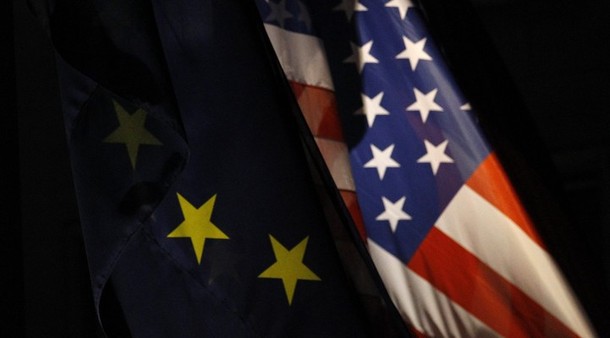Like Don Quixote’s pining for his princess Dulcinea, the generation-long quest for a U.S.-EU free trade agreement has been mostly an affair of fit and fantasy — that is, until now. In the last year, leaders across Europe have increasingly pushed for a new trade pact with the United States, their top trading partner, and a diverse constellation of special interests — from the business-minded U.S. Chamber of Commerce to the AFL-CIO, America’s biggest labor organization — have shown support. Earlier this month, a high-level working group, established in 2011 by EU and U.S. officials to study the feasibility of a trade agreement, signaled its intention to launch formal trade negotiations. And early next week, EU Trade Commissioner Karel De Gucht will travel to Washington to complete a long anticipated joint EU-U.S. report outlining likely objectives for such an accord.
The economic argument in favor of a free trade agreement is compelling. According to recent estimates by the International Monetary Fund, the United States will grow at less than 3 percent next year and the European Union will grow at less than 0.3 percent (assuming Greece and the other periphery countries remain part of the union). A free trade agreement would immediately improve growth prospects for both. Most large European companies operate in the United States, and collectively they employ more Americans than any other country — just as U.S. multinationals employ more Europeans than even important upstarts like Brazil and China. But plenty of impediments complicate transatlantic trade — from tariffs to conflicting governmental regulations — even when a company deals with its own affiliates. Removing these impediments, some economists predict, could add as much as 3 percent to both EU and U.S. gross domestic product.
Despite the obvious benefits, there may not be enough institutional capacity on either side of the Atlantic to close a deal. Even as European leaders have vocalized support for trade talks with the United States, the continent’s foreign economic policy has been cannibalized by the eurozone crisis and member state disputes on financial reform. Likewise, in the United States, resources to capitalize on the FTA opportunity are limited, despite the fact that domestic special interests have aligned in favor of a deal. The Obama administration has directed its diplomatic energy towards fast-growing Asia and the surging Pacific Rim, leaving Europe a relative backwater by comparison. Consequently, any proposed deal will not only have to be sufficiently rewarding to focus the attention of distracted political leaders, but it will also have to help bridge and engage an increasingly “post-Western” world of rising powers and states.
Given these impediments, there are three key ingredients for realizing a transatlantic FTA. Above all, any accord will have to be ambitious. Now is as good a time as any in the postwar period to tackle subsidies in sectors like agriculture since cash-strapped governments are looking for ways to trim fat. The focus, however, should be on regulatory coherence. In today’s global economy, technical regulations on issues like food safety and environmental standards impede trade more than most tariff barriers, even between partners like the United States and the European Union that have similarly high levels of regulatory supervision. A free trade agreement laying out common standards or a process for recognizing equivalent regulatory regimes can help minimize these distortions.
Second, and closely related, negotiations on regulatory coherence should take the opportunity to extend beyond food, labor, and the environment to additional sectors like financial services. Varying interpretations and asymmetric implementation of international best standards — from the G-20 agenda for derivatives to the Basel III capital regulations, designed to stabilize the financial system and prevent banks from failing — have occasionally led to cross-border recriminations that undermine growth and increase uncertainty. A free trade agreement should embrace transatlantic coordination in financial rulemaking and outline a flexible but thoughtful framework for synching cross-border administrative processes.
Finally, a transatlantic deal should be as much a global accord as it is a bilateral one. Both the European Union and the United States have a habit of concluding FTAs that aren’t so much free as they are preferential. As such, they tend to exclude non-participants, forcing them to come up with their own alliances. But as the global balance of power shifts eastward, and as trade negotiations increasingly tackle non-tariff issues, this exclusionary approach is becoming increasingly untenable. Washington and Brussels must ground a transatlantic free trade agreement in core principles of nondiscrimination. Other countries should be allowed improved access to U.S. and EU markets if they can demonstrate that they meet the regulatory standards that Europe and the United States advocate. In that way, emerging markets can be incentivized to adopt, instead of undercut, the best practices laid out in the transatlantic free trade agreement.
This last requirement, in particular, reflects the reality that a close transatlantic relationship not only makes good political sense, but is also smart global economics. An EU-U.S. trade agreement can bolster Atlantic as well as global growth; it can also allow the United States and the European Union to export standards and policies in addition to goods. Yet the finalization of a transatlantic free trade agreement is far from assured, perhaps, as Don Quixote rightfully remarked, because “not everyone is sufficiently intelligent to be able to see things from the right point of view.”
Chris Brummer is the C. Boyden Gray fellow on global finance and growth at the Atlantic Council. Frederick Kempe is the president and chief executive officer of the Atlantic Council. This piece first appeared on Foreign Policy.
Image: euusflags.jpg
